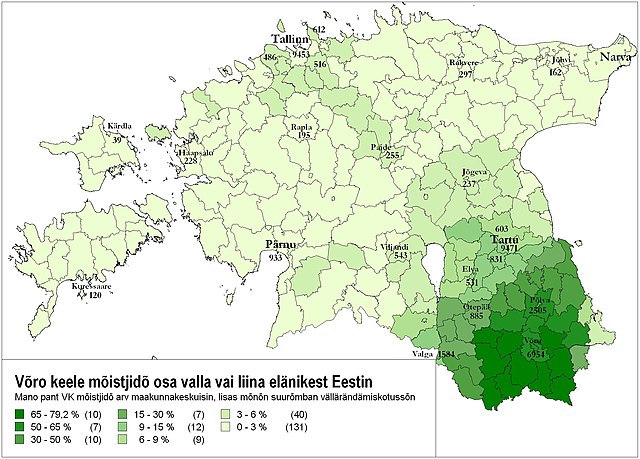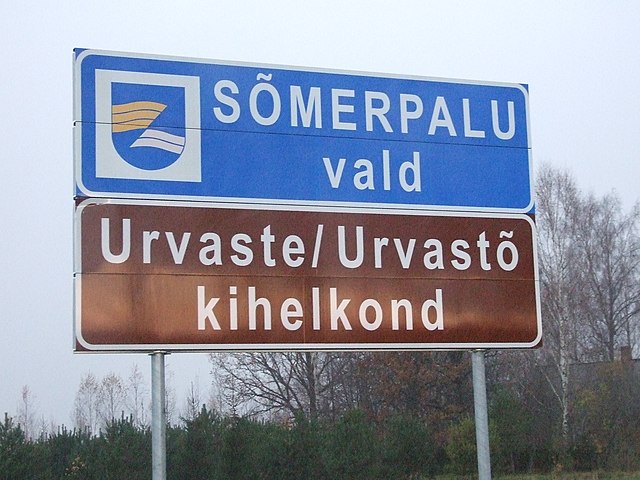Top Qs
Timeline
Chat
Perspective
Võro language
Dialect of the South Estonian language From Wikipedia, the free encyclopedia
Remove ads
Võro (/ˈvɒroʊ/ VORR-oh; Võro: võro kiilʼ [ˈvɤro kʲiːlʲ], Estonian: võru keel)[2][3] is a South Estonian language.[4][1] It has its own literary standard[5] and efforts have been undertaken to seek official recognition as an indigenous regional language of Estonia.[6][7] Võro has roughly 75,000[8] speakers (Võros), mostly in southeastern Estonia, in the eight parishes of the historical Võru County: Karula, Harglõ, Urvastõ, Rõugõ, Kanepi, Põlva, Räpinä and Vahtsõliina. These parishes are currently centred (due to redistricting) in Võru and Põlva counties, with parts extending into Valga and Tartu counties. Speakers can also be found in the cities of Tallinn and Tartu and the rest of Estonia.[9][10][11]
Remove ads






Remove ads
History
Võro is a descendant of the old South Estonian regional language and is the least influenced by Standard Estonian (which is based on Northern Estonian dialects).[12] Võro was once spoken further south and east of historical Võromaa in South Estonian-speaking enclaves Lutsi (Ludza), Leivu and Kraasna in what is now Latvia and Russia. In addition to Võro, other contemporary South Estonian languages are Mulgi, Tartu and Seto.
One of the earliest written evidences of South Estonian is a translation of the New Testament (Wastne Testament) published in 1686. Although the status of South Estonian began to diminish after the 1880s, the language began to undergo a revival in the late 1980s.[13]
Remove ads
Present situation
Today, Võro is used in the works of some of Estonia's best-known playwrights, poets, and authors (Madis Kõiv, Ülle Kauksi, Jaan Kaplinski, Ain Kaalep, etc.). One newspaper is printed in Võro: the fortnightly Uma Leht (literally Our Own Newspaper). Twenty six public schools offer weekly special classes (mostly extracurricular) in modern Võro.
Estonia's contribution to the Eurovision Song Contest 2004 was the song "Tii", which was performed by Neiokõsõ in Võro.
The language is endangered,[14] and according to Kadri Koreinik this is due to the government's lack of legal commitment to protect the language.[6]
Remove ads
Orthography
Võro employs the Latin script, like Estonian and Finnish.
| А /ɑ/ | B /p/ | C /t͡s/ | D /t/ | E /e/ | F /f/ | G /k/ | H /h/ | I /i/ | J /j/ | K /k/ |
| L /l/ | M /m/ | N /n/ | O /o/ | P /pp/ | Q /ʔ/ | R /r/ | S /s/ | Š /ʃ/ | T /t/ | U /u/ |
| V /v/ | W /v/ | Õ /ɤ/ | Ä /æ/ | Ö /ø/ | Ü /y/ | X /ks/ | Y /ɨ/ | Z /s/ | Ž /ʃ/ | ʼ /◌ʲ/ |
Most letters (including ä, ö, ü, and õ) denote the same sounds as in Estonian, with a few exceptions. The letter q stands for the glottal stop /ʔ/ and y denotes /ɨ/, a vowel very close to Russian ы (from 2005 written õ).
Palatalization of consonants is marked with an acute accent (´) or apostrophe (ʼ). In proper typography and in handwriting, the palatalization mark does not extend above the cap height (except uppercase letters Ń, Ŕ, Ś, V́ etc.), and it is written above the letter if the letter has no ascender (ǵ, ḿ, ń, ṕ, ŕ, ś, v́ etc.) but written to the right of it otherwise (bʼ, dʼ, fʼ, hʼ, kʼ, lʼ, tʼ). In some sources, an apostrophe is placed after the letter in all cases.
Phonology
Summarize
Perspective

Vowels
Vowel harmony
Võro has preserved the system of vowel harmony that was present in Proto-Finnic.[clarification needed] This distinguishes it from Estonian and some other Finnic languages, which have lost it.
The vowel harmony system distinguishes front, back and neutral vowels, much like the system found in Finnish. A word cannot contain both front and back vowels; suffixes automatically adapt the backness of the vowels depending on the type of vowels found in the word it is attached to. Neutral vowels can be combined with either type of vowel, although a word that contains only neutral vowels has front vowel harmony. The only neutral vowel is i, like in Votic but unlike Finnish and Karelian, where e is also neutral.
- The vowel ɨ (in the Võro orthography written with õ or y, see Orthography section) is considered a back vowel for harmony purposes, but does not participate in harmony itself, as it does not occur in suffixes and endings.
Some examples, with Estonian and Finnish included for comparison:
Consonants
All Võro consonants (except /j/ and /ʔ/) can be palatalized. The glottal stop (q, IPA [ʔ]) is a very common sound in Võro.
Remove ads
Grammar
Summarize
Perspective
Nouns
Endings are shown only in the back vowel harmony variant. The e of the illative ending does not undergo vowel harmony, so it never changes to õ.
Only the more common endings are shown. There are some unusual/irregular endings that are only found in a few words or word types.
Notes:
- The accusative is not usually considered a separate case in Võro grammars, as it is always identical to either the nominative or the genitive.
- When an ending beginning with d is attached to a stem ending in an obstruent, it is devoiced to t automatically.
Verbs
This section needs expansion. You can help by adding to it. (April 2015) |
The 3rd person singular of the indicative mood can be either without an ending or, alternatively, with an s-ending:
Among the Finnic languages, such double verb conjugation can be found only in the South Estonian and Karelian languages.
Negation
Võro has a negative particle that is appended to the end of the verb, whereas standard Estonian and Finnish have a negative verb, which precedes the verb. In Estonian and Finnish, the negative verb ei (Finnish en/et/ei/emme/ette/eivät) is used in both present and past negation, whereas in Võro the same is expressed by different particles ending with -i(q) or -s:
Remove ads
Language examples
Written examples

Article 1 of the Universal Declaration of Human Rights in Võro:
- Kyik inemiseq sünnüseq vapos ja ütesugumaidsis uma avvo ja õiguisi poolõst. Näile om annõt mudsu ja süämetunnistus ja nä piät ütsʼtõõsõga vele muudu läbi käümä.
As comparison the same sentence in Standard Estonian:
- Kõik inimesed sünnivad vabadena ja võrdsetena oma väärikuselt ja õigustelt. Neile on antud mõistus ja südametunnistus ja nende suhtumist üksteisesse peab kandma vendluse vaim.
In Finnish:
- Kaikki ihmiset syntyvät vapaina ja tasavertaisina arvoltaan ja oikeuksiltaan. Heille on annettu järki ja omatunto, ja heidän on toimittava toisiaan kohtaan veljeyden hengessä.
In English : All human beings are born free and equal in dignity and rights. They are endowed with reason and conscience and should act towards one another in a spirit of brotherhood.
Recorded videos
- Egle speaking Võro
- Sulev speaking Võro
- Jaan speaking Võro
- Maarika speaking Võro
- Toomas speaking Võro
Remove ads
See also
- Finnic languages
- South Estonian language
- Uma Leht, newspaper in the Võro language
- Võro Institute
References
Further reading
External links
Wikiwand - on
Seamless Wikipedia browsing. On steroids.
Remove ads


